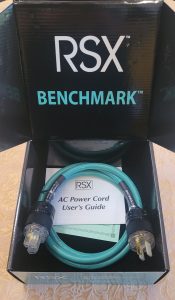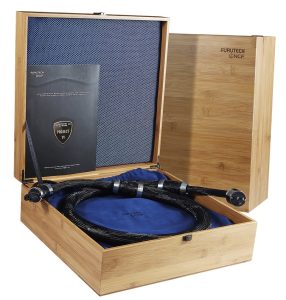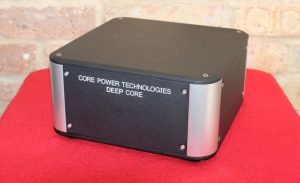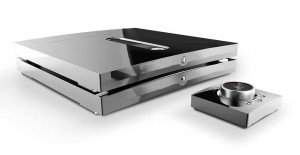The first inkling something outrageous was approaching came abruptly with the email teasers. Soon a conversation ensued (or, more accurately, a monologue) with Brian Ackerman, the Stage III Concepts distributor and proprietor of Aaudio Imports, about a product so far beyond the pale—a power cord weighing 35 lbs, essentially equal to three individual Stage III Kraken models, with the MSRP of three Krakens (that would be $22,000/1.5m)—that light-headedness and a sprinkling of skepticism quickly set in.
the Cutting Edge
Brian likes to hang out on the cutting edge—he claims to enjoy the view! Periodically he unveils one of these contenders. The last was less than two years ago, when the Cerberus Speaker Cable was introduced (MSRP $36,200/ 2m pair). Curiously, these edge dwellers seem to find a market and turn a profit. Otherwise, they would be delisted from the inventory, and I haven't seen that happen recently. In fact, my impression is much of the High-end business has moved to this ultra-pricey market niche.
That's good for me because I get to audition my share. It's exciting and I enjoy it, as long as there's no commitment. The edge dwellers are the first thing visitors notice and it stops them in their tracks. Rendered wide-eyed and immobile, they stage whisper, "What the Hell…what's that?" I stay chill, thinking the same. "Where can it go from here? There has to be an end point, right?" Wrong! After witnessing this scenario for so many years, the conclusion can only be that there isn't one; something always drops out of the wild blue yonder.
Denizens of the Deep
Since pushing the envelope is a high-adrenaline affair I do not recommended it for everyone, but for the deep-pocketed and those just plain curious, let's take a look. Stage III has a long standing practice of naming their best power cords after the mythical denizens of the deep. In order of ascendance, they are the Triton, Kraken, Proteus, and Leviathan. Each is more outlandishly overbuilt than the previous (or any other brand I know, for that matter). Each nudges the envelope a little further. Poseidon, the ruling deity of the seas, stands over them all. There he is, resting on the floor between the wall outlet and my HB PowerStar Horizon power distributor, pumping high octane fuel to my CH Precision M1.1 monoblocks.
Poseidon next to a 10" woofer
Let's break down the parts. Take three Kraken PCs (the exterior looks like a Kraken, but internally each wire lead—hot, neutral and ground—gets its own tube housing); seal each wire lead in an individual, heavily damped tube and suck the air out; then twist them in a helix configuration. That's right—each lead has its own vacuum chamber. Brian claims this might be the world's first vacuum dielectric power cord.
The Vacuum Dielectric
Y'all know what a vacuum does for interconnects. What happens if it's built into a PC? One thing is for sure—the presentation does not become light and airy. Oh, there's plenty of that, but, even more pronounced is grounding to the earth. The Poseidon is firmly planted on terra firma. Perhaps the naming affiliation with the sea refers to the liquid, or liquidity, aspect? Again, of that there is plenty. I'll speak more on this shortly.
What I hear surprises me on some levels, is not surprising on others, and is altogether in character for Stage III.
Poseidon, Proteus, Audience frontRow power cords
Why So Big?
First the obvious question: Why so big? That's easy; to accommodate extreme multi-layered damping and shielding. You might then reasonably ask, "What does that buy you, other than difficulty in installation?"
Damping and shielding are standard tools in cable design. Their positive side is formidable: to protect the signal and keep it virgin. They can also help tune the bass and dial in resolution. The downside is equally well-known: overused, you'll have closed-in, dull sound. This is where these Stage III cables get interesting. They use more of these tools than anyone, yet their cables sound far from closed-in. How do they do that?
In the concert hall, sounds can be localized at specific locations but one thing they are definitely not is closed-in. Live sound is free-range, constantly shifting in the dynamic domain. Getting images to behave in this manner from an audio rig is a big challenge, because the more involved you get in the hobby, the more the obsession with resolution gets in the way.
It's thrilling to hear deeply into a recording; resolution is great. The problem is that all too often dialing in focus has the side effect of stomping on fluid and free, resulting in images that behave stiffly. While equally laudable, these goals are on opposite sides of the balance scale. Because the preponderance of audiophile products push the resolution side, it's not easy to find ones that benefit both attributes.
the Analytic Anti-hero
On the one hand, the Poseidon has got to be the most resolving power cord I've encountered, dredging up previously unheard details and information, with every audible object nailed at precise coordinates, exactly where they're supposed to be. It is the ultimate in specificity.
Yet, as I mentioned, the sound has no constraints, nothing sounds stiff or static and everything flows.
It is almost as if the Poseidon gets to the level where the straitjacket of heavy damping would clamp down on the image, but then continues the dredging action to an underlying layer of information. Like shooting a scene in 16 mm film, with its coarse pixels and granularity, and re-shooting it in 35 mm. The edges soften even as you gain acuity.
The Stage III Poseidon turned out to be a revelation in this regard. Since I put it in, despite its extreme resolution, I can't think of a single recording that showed analytic qualities. You see the trumpets, the tympani, or the violins as individual players; then, if you want, zoom out and you get the whole section; zoom out some more, you can take in the entire stage.
Timbral Fulfillment
Another item on the unexpected side of the ledger: timbre enrichment. Stage III has always been strong in the timbre department and their power cords represent the sweet spot in their catalog. That's why I love the best-selling Kraken model. Still, swapping in the Poseidon, I hardly expected a jump in timbral fulfillment beyond the Kraken (or even the Proteus).
Maybe it was the extra dredging effort, excavating to a deeper level and increasing the pixel count. I suspect it's due to the vacuum dielectric. Without belaboring the point, let's just say timbral fulfillment leap frogged from A+ to the honors category.
The Bass
Finally, we've reached the item everyone's been expecting. Just looking at this muscle-bound guy, you know he's gonna throw a ton of low end. And that's what rolled out—ungodly crescendos that wash over you and shake up you physically. The dynamic range is wild; you'll think there's zero dynamic compression. This is the kind of low-end that takes you higher, to the realm that dreams are made of.
However, this low-end is wholly different from what you would get by alternative means, such as a subwoofer. Don't get me wrong. I'm a fan of subs, even if you have full-range speakers. Subs are great for fleshing out timid low-end response and clarifying the recording venue. But good luck with the set-up demons, like placement in the room, phase, cut-off frequency, and the slow speed of the bass driver. And the cut-off point imposed by their low-pass filter around 80Hz (or whatever it is set to) means forget about seamless integration with the midrange.
None of that applies to the Poseidon bass. There is no cut-off and it has excellent frequency integration. File this one under not surprising.
Burn-In
I was told to give the cable 300 hours for burn-in. My sample had seen some use and traveled cross-country. The first day it had a massive low-end and a closed-in top. After 24 hours, the top opened up. After about two weeks of moderate use, the low-end started to dissipate and frequency response stabilized, with slightly more bass than the Proteus (which, in turn, has more low-end than the Kraken). To complete the in situ voicing, I only had to remove a Furutech NCF Cable Booster, which had been supporting the Proteus at the wall outlet. The Furutech enhances the bass, which the Poseidon certainly didn't need. (It also imparts its own coloration, but we'll save that discussion for another time.) Now the Poseidon was good to go.
Note that it's not as if darkness descended over the soundscape. The extra thrust and low-end support only kicks in as dictated by the signal, it's not a persistent, lingering coloration.
Build Quality and Construction
I have other power cords in my library with individual runs for hot, neutral, and ground (i.e., the AudioQuest Dragon and the Argento FMR EE). They are dwarfed by the Poseidon and don't look anything like it. The sheer bulk and physical weight make the Poseidon unique in audio.
Like the other Stage III denizens of the deep, the cable is wider in the middle and stepped down at the ends. One difference we'll all appreciate is the longer and more flexible pigtail at each end. This makes it so much easier to work with than the Proteus (or the Kraken, for that matter). From the wall, the pigtails lead into a shockingly massive housing, where the three wires are separated and exit as individual runs. This section of the cable is so heavy and stiff you'll want to lay it on the floor: forget about third-party cable supports unless they have a high-weight bearing capacity.
Aaudio booth at the LA Show
Conclusion
Stage III Concepts specializes in power cables. It makes sense a specialist would introduce the next major design innovation: a power cord with a vacuum dielectric. What a difference the Poseidon makes! It has wondrous timbral beauty; at the same time, it delivers thunderous low-end. To put a number on it, I'd say the Poseidon singlehandedly garnered an 8-10% improvement in my system. In a rig conservatively valued at more than a half million USD, an 8% upgrade would translate to at least $40,000. No, I'm not gonna make a case that the thing is a bargain (although the numbers support that), only that it might be fair value for the bang it delivers.
But why does it have to be so big? As Brian put it: when the criminal at large is as damaging and pervasive as RFI, anything you can do to combat it—at any expense or cosmetic—is worthwhile.
What a monster this guy is! But he's the best yet from Stage III or any brand I've heard, bar none.
Poseidon Power Cord
Retail: $22,000/1.5 m; add $6,150 per 0.5/m
Stage III Concepts
Distributor information
Aaudio Imports




















































